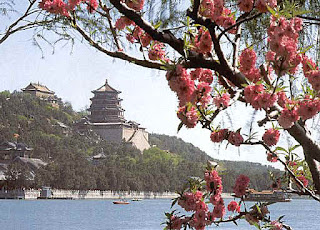
The Summer Palace in Beijing – first built in 1750, largely destroyed in the war of 1860 and restored on its original foundations in 1886 – is a masterpiece of Chinese landscape garden design. The natural landscape of hills and open water is combined with artificial features such as pavilions, halls, palaces, temples and bridges to form a harmonious ensemble of outstanding aesthetic value.
Around 16 km northwest of Beijing, the great aesthetician, Emperor Qianlong (1736-1795) had built a masterpiece of garden art and architecture, "Yuanming Yuan", better known under the name "The Old Summer Palace. It was erected in the most lavish style ever seen in China, and planned by the Italian Jesuit missionary and artist Giuseppe Castiglione, who had the castle of Versailles in his mind for pleasing the emperor. But during the second Opium War (1856-1860) the western powers, headed by the British and French governments, plundered the palace and transformed it into brickbats.
Cixi, originally concubine of the third rank, instated herself on the Dragon Throne after the Emperor's death, and reigned China in a most unscrupulous and egocentric way for the next 50 years, to begin with in her youngest son's name. By the help of young women and other secular temptations she kept him away from politics until his death as 18 years old.
Disregarding the established hereditary order she now instated her young nephew as emperor, but continued reigning "behind the throne" until he had come of age. At this moment she finally retired to Yiheyuan Palace.

The Summer Palace and the Pagoda.
The Summer Palace in Beijing is an outstanding expression of the creative art of Chinese landscape garden design, incorporating the works of humankind and nature in a harmonious whole.The Summer Palace epitomizes the philosophy and practice of Chinese garden design, which played a key role in the development of this cultural form throughout the East. The imperial Chinese garden, illustrated by the Summer Palace, is a potent symbol of one of the major world civilizations.

Constructed in the Jin Dynasty (1115-1234), during the succeeding reign of feudal emperors; it was extended continuously. By the time of the Qing Dynasty (1644-1911), it had become a luxurious royal garden providing royal families with rest and entertainment. Originally called 'Qingyi Garden' (Garden of Clear Ripples), it was know as one of the famous 'three hills and five gardens' (Longevity Hill, Jade Spring Mountain, and Fragrant Hill; Garden of Clear Ripples, Garden of Everlasting Spring, Garden of Perfection and Brightness, Garden of Tranquility and Brightness, and Garden of Tranquility and Pleasure). Like most of the gardens of Beijing, it could not elude the rampages of the Anglo-French allied force and was destroyed by fire. In 1888, Empress Dowager Cixi embezzled navy funds to reconstruct it for her own benefit, changing its name to Summer Palace (Yiheyuan). She spent most of her later years there, dealing with state affairs and entertaining. In 1900, it suffered again, being ransacked by the Eight-Power Allied Force. After the success of the 1911 Revolution, it was opened to the public.
Composed mainly of Longevity Hill and Kunming Lake, The Summer Palace occupies an area of 294 hectares (726.5 acres), three quarters of which is water. Guided by nature, artists designed the gardens exquisitely so that visitors would see marvelous views and be amazed by perfect examples of refined craftwork using the finest materials.
Centered on the Tower of Buddhist Incense (Foxiangge) the Summer Palace consists of over 3,000 structures including pavilions, towers, bridges, and corridors. The Summer Palace can be divided into four parts: the court area, front-hill area, front-lake area, and rear-hill and back-lake area.
Front-Hill Area: this area is the most magnificent area in the Summer Palace with the most constructions. Its layout is quite distinctive because of the central axis from the yard of Kunming Lake to the hilltop, on which important buildings are positioned including Gate of Dispelling Clouds, Hall of Dispelling Clouds, Hall of Moral Glory, Tower of Buddhist Incense, the Hall of the Sea of Wisdom, etc.
Rear-Hill and Back-Lake Area: although the constructions are fewer here, it has a unique landscape, with dense green trees, and winding paths. Visitors can feel a rare tranquility, and elegance. This area includes scenic spots such as Garden of Harmonious Interest and Suzhou Market Street.
Court Area: this is where Empress Dowager Cixi and Emperor Guangxu met officials, conducted state affairs and rested. Entering the East Palace Gate, visitors may see the main palace buildings: the Hall of Benevolence and Longevity served as the office of the Emperor, the Hall of Jade Ripples where Guangxu lived, the Hall of Joyful Longevity, Cixi's residence, the Hall of Virtue and Harmony where Cixi was entertained.
Front Lake Area: covering a larger part of the Summer Palace, opens up the vista of the lake. A breeze fluttering, waves gleam and willows kiss the ripples of the vast water. In this comfortable area there are the Eastern and Western Banks, the Seventeen-Arch Bridge, Nanhu Island, and so on. On the western bank float six distinct bridges amongst which the Jade-Belt Bridge is the most beautiful.
Admission Fee:CNY 25 (Nov. 1 to Mar. 31)CNY 35 (Apr. 1 to Oct. 31)
Opening Hours: 07:00-17:00 (Nov. 1 to Mar. 31)06:30-18:00 (Apr. 1 to Oct. 31)
Recommended Time for a Visit: One and a half hour
Bus Route: 907, 375, 801, 808, 732, 394, 718







Engin ummæli:
Skrifa ummæli